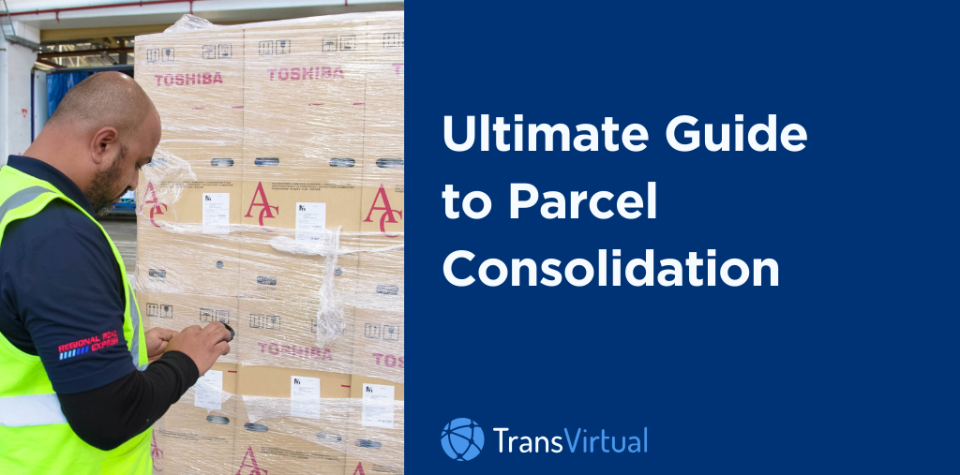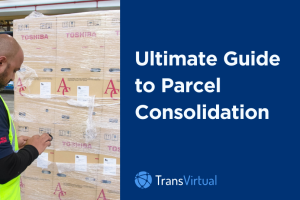Table of Contents
Global eCommerce expects to account for 22% of retail sales in the next few years. So how are companies going to keep up with the increasing demand for online deliveries?
With the 2020 pandemic catapulting online shopping to new heights, carriers, freight managers and delivery drivers are struggling to keep up.
Parcel shippers had to rethink their delivery methods to meet customer standards and reduce shipping costs.
Parcel consolidation proved an excellent delivery method for shippers. Allowing them to use centralised dispatching to merge single parcels into one shipment.
If you are shipping many packages this could be a great method for you too. Our guide to parcel consolidation will help you understand more about how it works, its benefits and why it may work for you.
What Is Parcel Consolidation?
Parcel consolidation (or package consolidation) is an efficient and cost-effective method to transport freight shipments. A parcel consolidation service often uses centralised dispatching so all shipments are sent from a single location.
It’s especially great for shipping lightweight packages in high volumes and find the freight costs and shipping charges are too high. Parcel consolidation could be a great method to solve this problem.
Parcel consolidation services are also common for companies that offer international shipping. By combining multiple packages, you get to streamline delivery and simplify customs clearance.
How Does Parcel Consolidation Work?
As the name implies, consignors (or shippers) combine shipments addressed to the same city into a single shipment or truckload. The single shipment can contain individual parcels from different shippers too.
The consolidated shipment is then sent to that cities’ carrier’s terminal. From there, it’s dispatched into the postal system for final delivery.
For example, let’s say you have 10 different shipments all going to the same location. You can use parcel consolidation to turn them into one single parcel.
But if you treated these as 10 shipments you would have to pay for each of their shipping charges. So consolidating the shipments means reducing shipping costs.
Benefits of Parcel Consolidation
Parcel consolidation has many benefits and advantages for both shippers and carriers. Let’s look more into each of the benefits, so you can understand why package consolidation may work for you.
Save Time Delivering
When the responsibility of a delivery falls into the carrier’s hands, it can speed up the delivery time. That’s because when less parties are involved, like suppliers and shippers, the process is often smoother and more efficient. Packages arrive from the shipper’s centralised dispatching warehouse. Then they’re distributed by the postal system from the same carrier terminal.
This improves dispatching efficiency, as the shipper spends time prior, planning and organising consolidated parcels. Assuring correct parcels reach the carrier’s intended city terminal.
Cost savings
One major benefit of consolidating packages destined for the same location is cost. Using a single carrier means a single freight bill. These reduce shipping charges as shippers pay only for a single shipment.
Some carriers’ parcel consolidation strategies mean you can avoid some accessorial shipping fees. Such as residential surcharge, delivery area surcharge or Saturday delivery shipping charges.
Damage and Loss Risk Improvement
Half of online customers have experienced parcel delivery issues since the pandemic began, citing problems such as missing or damaged parcels.
In parcel consolidation, the carrier takes responsibility for the shipment. From the first mile, to the final delivery location, making a carrier’s package consolidation service efficient for shippers.
But it also reduces the touch-points within the delivery system. When freight travels from the shipper to the carrier terminal, then onto the parcel receiver, it reduces handling and lowers the risk of damage or loss.
Improved Quality Control
Improved quality control is another benefit of centralised dispatching using parcel consolidation. This allows shippers to perform quality control checks on goods when they’re delivered. The shipper has greater control over what leaves the centralised warehouse.
When shippers fix problems with individual shipments before they get sent out, there’s less likelihood of problems further down the chain.
Disadvantages of Parcel Consolidation
Although parcel consolidation has many benefits, it has its downsides. We will explore these risks, so you can determine if this system can work for you.
Need to Plan
As with any complicated system, the consolidation process needs more planning and effective strategy. You need to consider factors such as parcel dimensions, cost and timely delivery. Staying on top of these improve your changes of having your shipment arrive safely.
You prolong the shipping process
With some much planning and waiting going on, you end up prolonging the entire shipping process. You also have to wait for full load so you can maximise cost and efficiency.
Not only that, all parcels need to be sorted and processed, adding to the overall time it takes to reach its final destination.
Difficult to Find a Carrier
Not all carriers want to ship consolidated parcels, due to the complexity and time it takes to fulfil orders. Once you find a carrier happy to take on consolidated parcels, you need to factor in the cost. While building an informed relationship between the shipper and the carrier.
It can be difficult to find the right carrier and assure that you are getting a fair price for the services provided. Partnering with a freight provider can help you determine if the deal you make with the carrier is fair or not.
Is Parcel Consolidation Right for You?
Hopefully this guide to parcel consolidation has taught you more about the service. It works by using centralised dispatching to leverage a carrier’s capability to deliver shipments.
The benefits it offers for shippers, freight companies, carriers and delivery drivers are significant. It helps you to reduce cost and delivery time, while improving quality control and lessening the risk of damage.
However, like most things, it has some disadvantages too. Some inconveniences we covered was the time consuming consolidation process and difficulty in finding a carrier.
Do you feel better equipped to weigh up the advantages and disadvantages of parcel consolidation? Contact our friendly support team if you have any questions. If you want to learn more about how parcel consolidation can work for you our team is here to help, you can also book a personalised demo.



